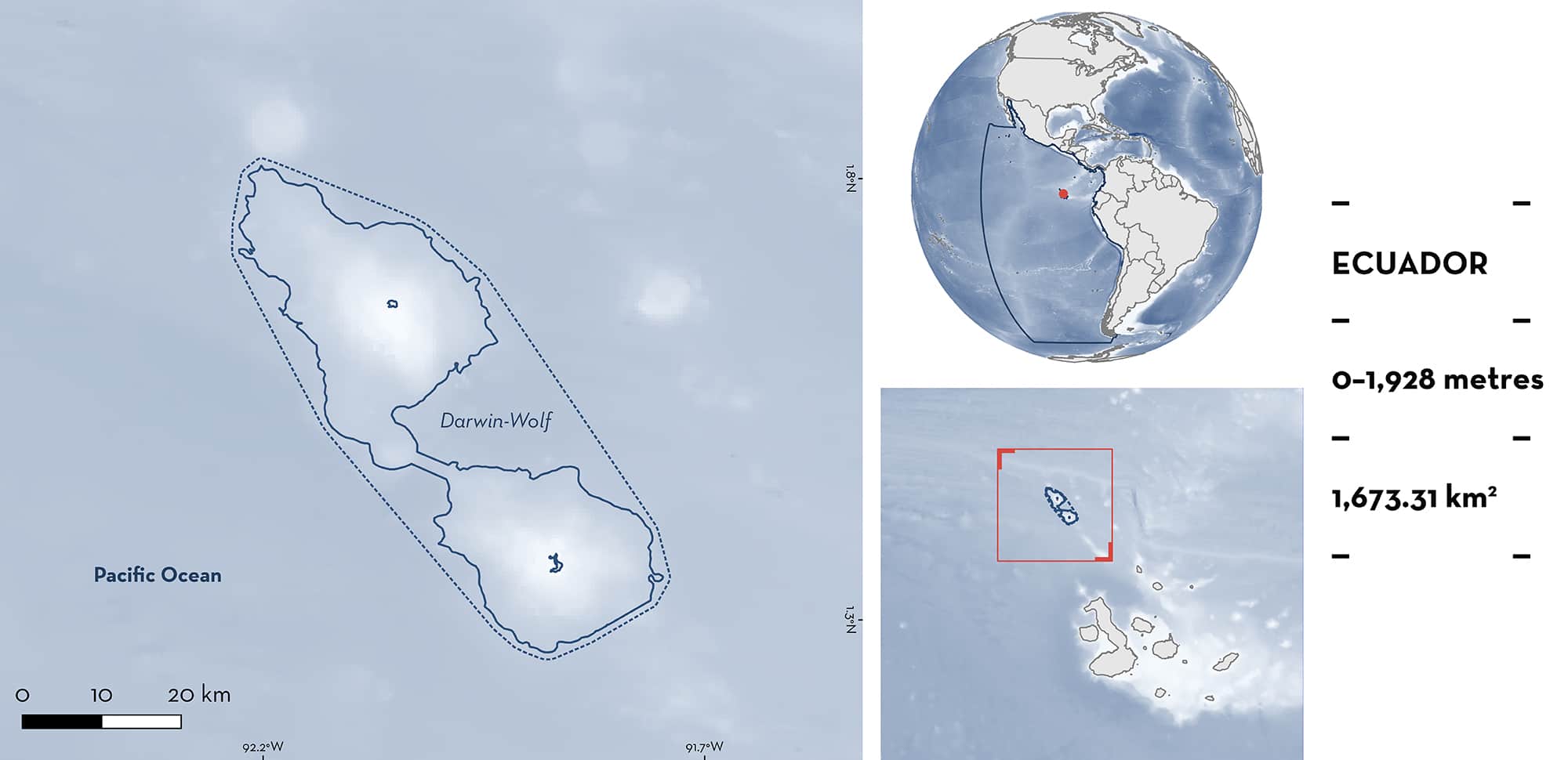ISRA FACTSHEETS
ISRA FACTSHEETS
CENTRAL AND SOUTH AMERICAN PACIFIC REGION
Darwin-Wolf
Summary
Darwin-Wolf is part of the Galápagos Archipelago, located ~950 km west of mainland Ecuador, and just off the southern edge of the Cocos Ridge. The area is within the Galápagos Marine Reserve – a designated UNESCO World Heritage Site and Biosphere Reserve, and two Ecologically or Biologically Significant Marine Areas. The area includes two oceanic islands, approximately 35 km apart, separated by deepwater. Habitats include exposed rocky shores, sand and rock substrates, and coral reefs. Within this area there are: threatened species (e.g., Silky Shark Carcharhinus falciformis); areas important for movement (e.g., Scalloped Hammerhead Sphyrna lewini); and undefined aggregations (e.g., Whale Shark Rhincodon typus).
Download factsheet
Darwin-Wolf
DESCRIPTION OF HABITAT
Darwin-Wolf is located ~950 km west of mainland Ecuador, and just off the southern edge of the Cocos Ridge. Darwin Island and Wolf Island, the most remote islands of the Galápagos Archipelago, reside within the Galápagos Marine Reserve – a designated UNESCO World Heritage Site and Biosphere Reserve, and two Ecologically or Biologically Significant Marine Areas, Archipiélago de Galápagos y Prolongación Occidental and Corredor Marino del Pacífico Oriental Tropical. They are located 140 km north of the main Galápagos Archipelago, and together form their own far-northern bioregion (Edgar et al. 2004).
Darwin Island has a submerged rocky platform at a depth of ~10 m that extends ~1.5 km to the southeast then drops steeply into water >100 m deep. Wolf Island is 35 km to the southeast of Darwin Island, and is surrounded by islets and exposed rocks, with a shoreline that drops steeply into water hundreds of metres deep. While equatorial, the Galápagos Archipelago is located at the confluence of three major oceanic currents and subsequent upwelling brings cold water to the islands, resulting in seasonally cool water temperatures from July to November of 18–23°C (especially in the western upwelling region of the archipelago), with warmer temperatures from December to June of 21–27°C (with the higher temperatures experienced in the far northern bioregion), although temperatures and productivity vary during strong El Niño–Southern Oscillation cycles.
This Important Shark and Ray Area has been delineated from inshore and surface waters (0 m) to a depth of 1,928 m based on the depth range of Qualifying Species in the area.
CRITERION A
VULNERABILITY
Three Qualifying Species considered threatened with extinction according to the IUCN Red List of Threatened SpeciesTM regularly occur in the area. These are the Critically Endangered Scalloped Hammerhead (Rigby et al. 2019), the Endangered Whale Shark (Pierce & Norman 2016), and the Vulnerable Silky Shark (Rigby et al. 2021).
CRITERION C
SUB-CRITERION C4 – MOVEMENT
Darwin-Wolf is an important area for the movement of two shark species.
Darwin Island (and to a lesser extent Wolf Island) may be a navigational waypoint to direct Whale Sharks to the resource-rich tropical instability waves that propagate down the Equatorial Front (Ryan et al. 2017). Over 50 adult female Whale Sharks have been tracked with satellite tags moving along the Equatorial Front predictably from July through October over multiple years (Hearn et al. 2016, 2017). Individuals migrate west from the Galápagos Islands along the front before returning through the same area back past the Galápagos Islands and on towards mainland Ecuador and Peru (Hearn et al. 2021). This area appears to be an important stopover point for this species with most tagged animals exhibiting a 1–2 day residency (maximum 8 days) at Darwin-Wolf before moving west to the resource-rich Equatorial Front (Acuña-Marrero et al. 2014).
Over 25 tagged Scalloped Hammerheads have been recorded frequently moving between Darwin Island and Wolf Island. In many cases, the timeframe it took for the individuals to make this movement (35 km in 19 hours or less) suggests that it was direct (Hearn et al. 2009). Moreover, large-scale annual movements have been recorded with eight (of 35) individuals’ satellite-tagged at Darwin-Wolf detected at Cocos Island (690 km away) from March through June (Nalesso et al. 2014; Ketchum et al. 2014a; Hearn et al. 2010, 2017).
CRITERION C
SUB-CRITERION C5 – UNDEFINED AGGREGATIONS
Darwin-Wolf is an important area for the aggregation of two shark species.
Up to 20 adults Silky Shark are commonly observed behind anchored vessels at Darwin Island (Alex Hearn pers. obs. 2022). Acoustic tagging of 15 individuals indicates long-term site residency and fidelity for Silky Sharks within the area, with some individuals showing repeated presence for over three years at both Darwin Island and Wolf Island (Hearn et al. 2017; Garcia-Zambrano 2021).
Scalloped Hammerheads are observed schooling daily in large numbers (commonly >200 individuals) at the windward side of both Darwin Island and Wolf Island. These ‘hotspots’ are less than 0.5 km2 in size, and individuals are observed circling singly or in schools, often interacting with cleaner fish (Ketchum et al. 2014a). At night, individuals disperse several kilometres offshore, presumably to forage (Hearn et al. 2010; Ketchum et al. 2014b). There is a seasonal reduction in the number of Scalloped Hammerheads from March through June when some individuals undertake large-scale migrations, although year-round presence persists (Nalesso et al. 2014; Ketchum et al. 2014a; Hearn et al. 2010, 2017).
Download factsheet
SUBMIT A REQUEST
ISRA SPATIAL LAYER REQUEST
To make a request to download the ISRA Layer in either a GIS compatible Shapefile (.shp) or Google Earth compatible Keyhole Markup Language Zipped file (.kmz) please complete the following form. We will review your request and send the download details to you. We will endeavor to send you the requested files as soon as we can. However, please note that this is not an automated process, and before requests are responded to, they undergo internal review and authorization. As such, requests normally take 5–10 working days to process.
Should you have questions about the data or process, please do not hesitate to contact us.


